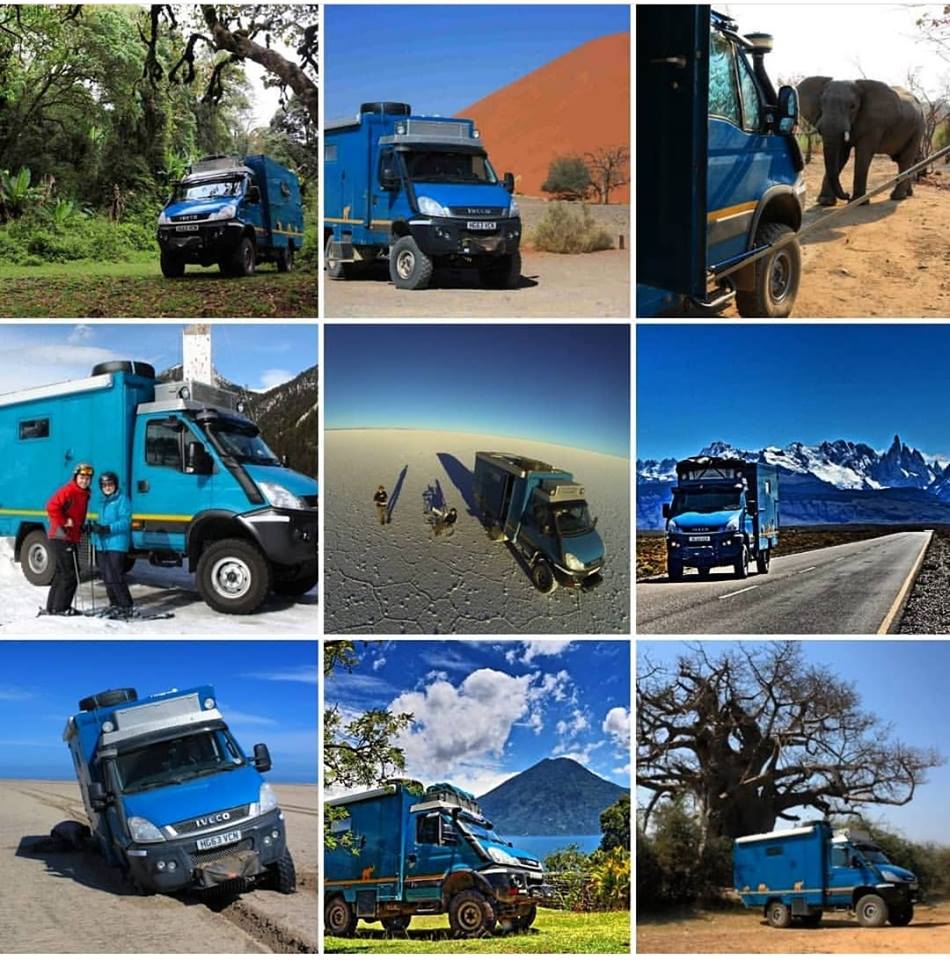So you want to hit the road? Be one of these adventurous, overlander people, travelling the world, going to far-flung and remote places, meeting people, seeing marvelous things? Okay…. choosing an overland vehicle is easy, right? Just buy an old 4×4 (oooh… maybe an iconic Land Rover?) chuck in some camping gear or a roof-tent and you’re off! Well, yes… it’s easy if you’re a rough, tough, ‘cold-and-wet-doesn’t-bother-me’ kind of adventurer. Problem is… we’re not.
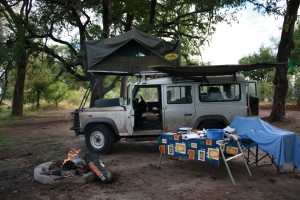
What if like us, you’re a bit of a softie? What if like us, the prospect of sleeping in a tent, or the back of a car every night, with cooking and ablutions outside, in all conditions isn’t really your thing? Being a softie shouldn’t put you off the idea of overlanding. After eight years of full-time travelling across Africa, Europe, South, Central and North America in Cuthbert our camper-truck, we look back at our choosing an overland vehicle for softies.
Travel with a few comforts doesn’t necessarily require a massively bigger budget when choosing an overland vehicle. And it doesn’t necessarily mean compromising on 4×4 off-road capability. Whether you are fortunate enough to be getting a brand-new professional build, choosing a pre-loved camper with a few thousand kms under the belt, or whether you are fitting out your own rig, the same principles apply when you want your comforts. Choosing an overland vehicle is very much not an analysis of specific base-vehicle types and capabilities. There’s lots of stuff on the web by macho guru-guys claiming the ‘my diff-lock’s bigger than your diff-lock’ thing. This is about choices for practicality and above all, a comfortable lifestyle on the road.
Where to start? choosing an overland vehicle
Many overlanders claim to have the perfect vehicle and kit. But that’s for them. Everyone has different priorities, plans and budgets when choosing an overland vehicle. What do you want for your travels? We can’t stress this enough… there is no perfect overland vehicle. We hope this helps give you some ideas to think about what you want in your vehicle.
For us, a few holidays in Africa renting a Land Rover with a roof-tent, plus overlanding in our Toyota Fortuner around the Middle East with a ground tent, gave us an insight into the overlanding lifestyle. It confirmed our suspicions: huge fun though camping is… it’s not really our idea of a lifestyle. We are not planning ‘a trip‘, we are planning our open-ended future on the road. We won’t be escaping winter weather when it gets cold. And we won’t be ‘flying home‘ every year for a couple of months for travel breaks. This vehicle will be our home, our permanent, long-term home. We will literally be living the mantra ‘Home is where you park it‘. So as a starting point when choosing our overland camper, we knew that we needed a hard-sided space to live in.
Okay… that’s a start… but what else?
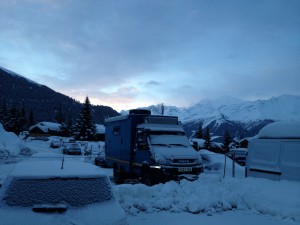
A bit of research threw-up some initial ‘big picture’ questions for us to ponder: Where are we going and how long for? We need the right tool for the job. Rough African bush? Smooth European highways? Muddy Amazon jungle? Freezing Canadian Arctic? Or a bit of all these? We definitely needed a 4×4, high-clearance, off-road capable vehicle that would potentially take us through all these conditions, but remember… we’re softies… we want our comforts.
The base vehicle/accommodation conundrum is a bit of a ‘chicken and egg’ situation: which comes first? A base-vehicle that can support your preferred type of accommodation, or an accommodation type that fits on your vehicle?
We considered 5 broad vehicle category options:
- small conversions inside a 4×4 (eg Land Rover/Land Cruiser converted with internal bed)
- slide-on/off hard-sided living cabins on the back of a pick-up (eg Toyota Hi-Lux)
- integral combi-camper/cars (eg VW Synchro)
- mid-sized living cabin on a mid-sized truck-chassis (e.g. Mercedes Sprinter, Iveco Daily)
- large living cabin/box on a ‘big-rig’ truck (e.g. MAN or Unimog )
Then we started to focus on a few more detailed points to narrow down those five options: Destination, Weight and Shipping
Destination
There’s no need for an off-road 4×4 to cruise Route 66 or to tour Europe. But destination Africa or the remote Amazon will require a rugged 4×4 with high-clearance. Our research showed how quickly a beautiful but ‘non-rugged’ camper will disintegrate before your very eyes if it is punished relentlessly on rough, bone-shaking routes. Also important with destination is the remoteness. Remote places (which we want to go to) need more water, more food and more fuel. This led us nicely to…
Weight
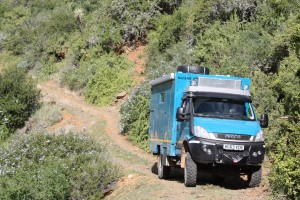
Our research flagged-up how easy it is underestimate the importance of the vehicle’s weight capacity and its distribution between the axles. It’s a simple law of physics and engineering that any vehicle that is overloaded with life’s little luxuries will eventually fail through over-stressing, particularly if used for long periods in rough conditions.
Hmmm… so how much weight will we have? Time to get the scales out and weigh some stuff. We made a rough assessment of all the goodies we wanted to put on/in our vehicle: all the equipment (incl tools, table/chairs, crockery and kitchen equipment, IT/laptops etc); fuel; water; food and drink; bedding and towels; toiletries, medicines and first-aid; personal effects; clothes and shoes; sports gear… Enough? We had no clue at that stage what sort of internal and external fittings we’d want, but even without these, it’s a proper eye-opener when you add it all up!
Before we did this weighing-up, we had been eyeing-up vehicle Options (1) or (2); dreaming of bouncing across the African bush in an old Landy. But wait…. bugger…. it just won’t fit! ☹ (click here for Marcus’ more technical write-up on this). Of course, we could have simply reduced our list of stuff… but that would have defeated that ‘comfort’ thing we were after.
This weight assessment ruled out pretty much all of the Option (1) and Option (2) vehicles (at least the slide-off trucks available in Europe; had we been in the USA there would have been some slide-off options open to us). It also ruled out some, but not all of the Options (3) combi-camper vehicles (those with a carrying capacity of up to 3.5T wouldn’t cope with our ‘comfort’ requirements). The choice left was a few of the larger Option (3) combi-campers; the Option (4) mid-sized trucks, or the Option (5) big-rigs.
Shipping
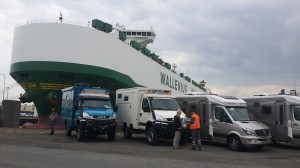
Next, we thought about the inevitable shipping conundrum. According to overlander forums and established lore, all vehicles must fit into a container; failing to do this will require ro-ro shipping which guarantees that you will lose all your possessions and have your vehicle stripped of every removable item when you send it off by sea ☹. Really?
We didn’t want a few weeks of shipping to dictate the all-important comfort of years of living in the vehicle. There’s an Old English proverb about that… something to do with ‘the tail wagging the dog’. We decided not to let shipping dictate our vehicle choice (click here to see more on the shipping decision). This left vehicle options (3), (4) and (5) all still in the running, but it did encourage us to consider some security measures, e.g. strong lockable door from front to back cabs to minimise the roro shipping risks.
So now we were getting down to the nitty-gritty…. We did lots more research then drew-up a Wish List to try to narrow down the categories further. Admittedly, our Wish List was a bit ‘pie-in-the-sky’, but we had to start somewhere, why not aim high?
Making a Wish List
This is the Wish List we ended-up with, in an approximate order of priority for us:
Climate protection
Our initial destination was a warm climate, but for longer term we wanted water-tight, solid-side accommodation with good insulation and protection from all the elements: extreme cold; strong winds; storms; driving rain/hail/snow.
Flexibility of park-up locations
Countryside or city-centre parking-up. Where it’s necessary, we want to be inside, able to sleep, cook, watch a DVD… whatever… without obviously ‘camping’ on city streets/car-parks.
A ‘home on wheels’, not a ‘car with a bed’
We plan to live permanently in the vehicle, everywhere, all year round. No hostels or lodges. When we thought this through, we realised that we really needed a box with a bit of space. We don’t need room to tango 😊, but height to stand-up straight and just move around a little bit would come within our definition of ‘comfort’ on the road. We also wanted a permanent double bed. Hmmm… could be asking a bit much. For us, this aspect was the toughest decision. Here’s what we found on this:
A fixed bed is convenient, but takes up precious living space. Some camper-vans get around this by having the fixed double bed above the front driving cab, but this adds a lot to the overall height and it becomes a more cumbersome vehicle.
A fold-away bed is a daily hassle, and you need somewhere for the bedding when the bed is stowed. It also usually means that the living area is surrendered to deploy the bed, e.g. there is no space for person No.2 if person No.1 wants to sleep.
A semi-permanent bed is a half & half. A permanent single bed pulls-out to form a double bed. It was a compromise, but this is what we decided in the end.
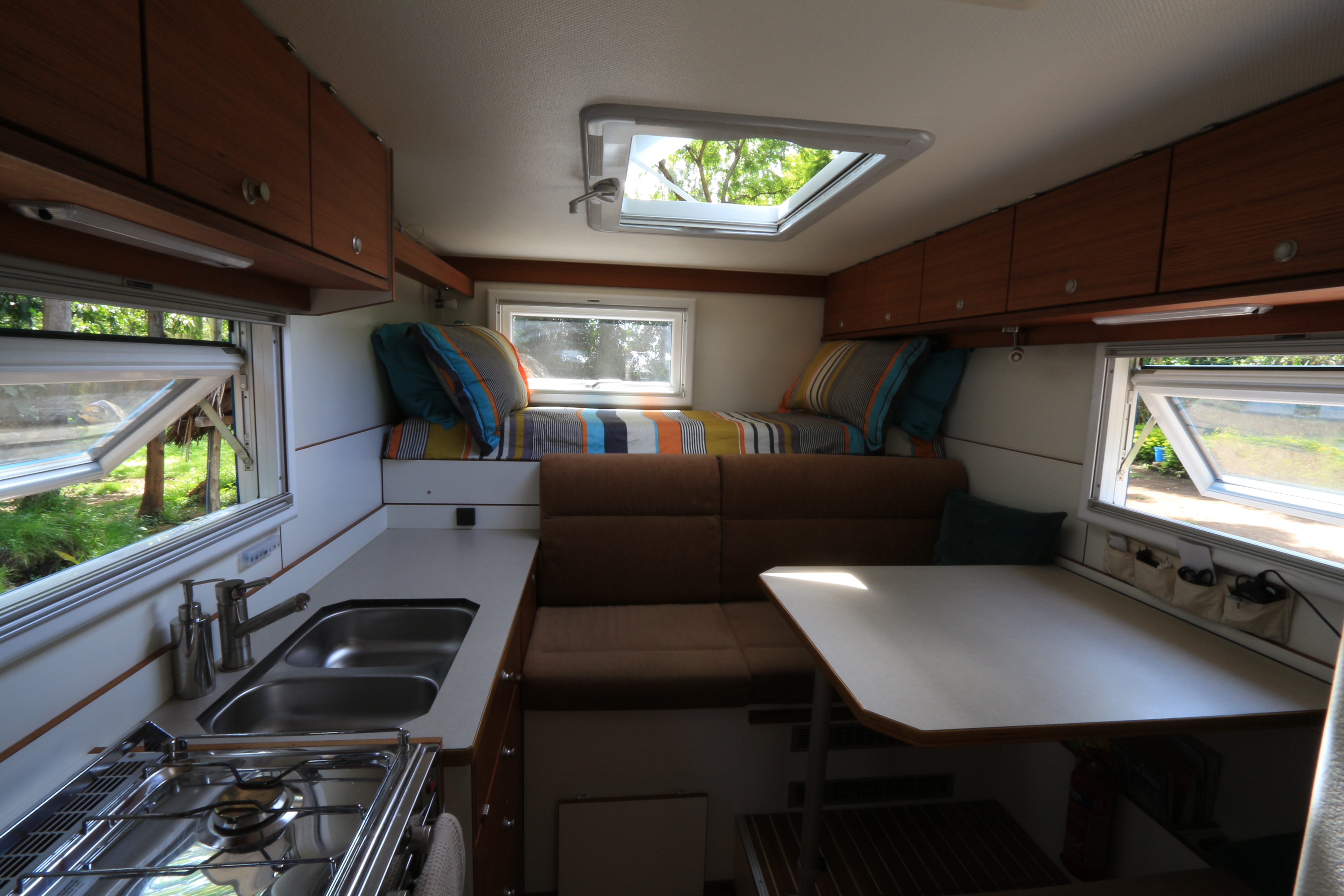
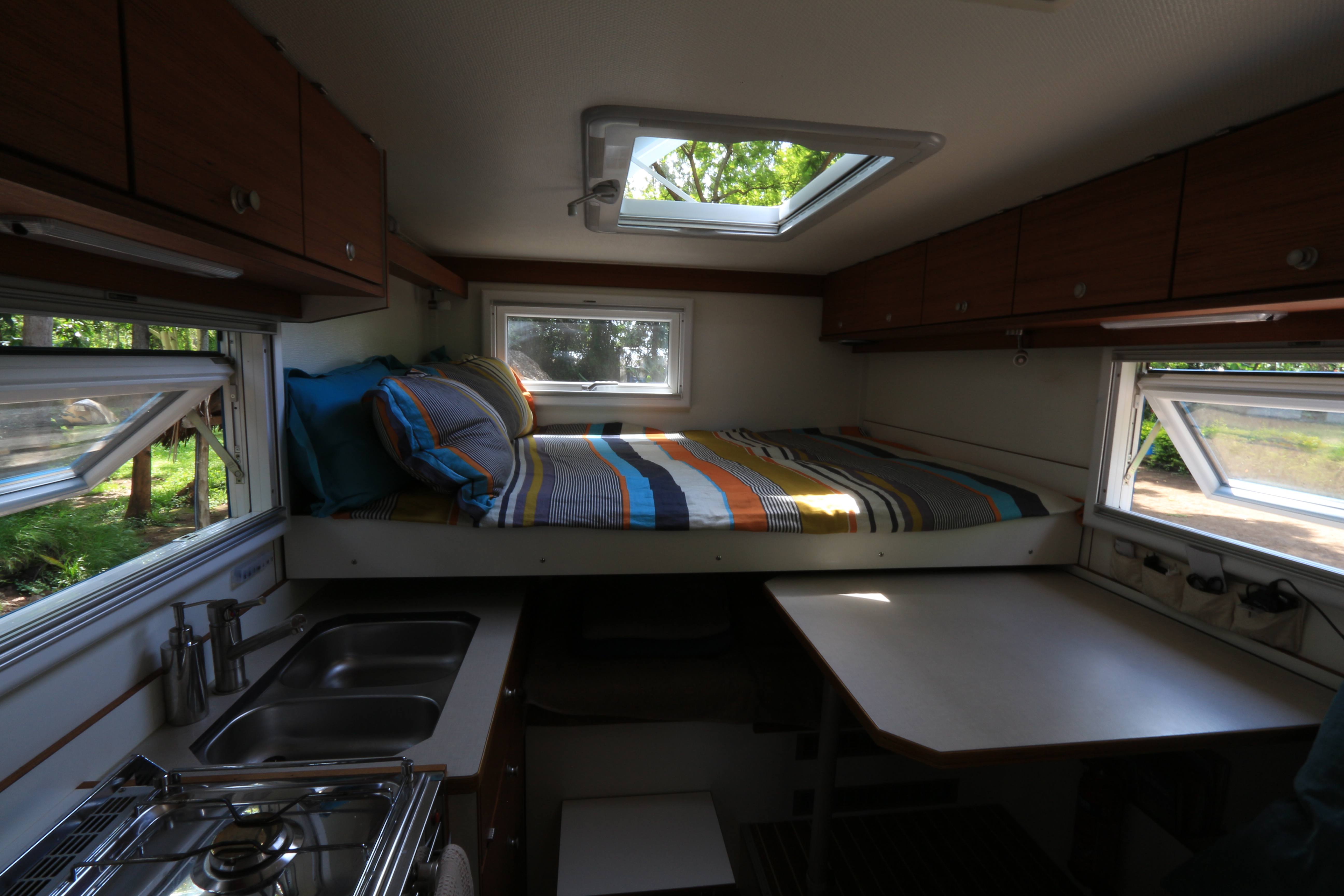
Water and bathroom
A toilet was essential for us, as was a fresh water tank with a filtration system for safe drinking water. We also wanted a grey-water tank so that we can save waste-water to dump in suitable, eco-friendly locations. This is also important for ‘Flexibility of camping locations’ (see above) – we don’t want to be dumping grey-water directly onto city streets.
Power
We wanted to be self-sufficient ‘off-grid’ in remote locations. Solar power seemed the obvious choice for lighting, refrigeration and sockets for appliances. We wanted gas for cooking and probably also for heating, although we were considering diesel for this too.
Temperature control
Some kind of heating was an essential luxury for us. I’m the biggest cold-weather softie of all time. We plan to be in some very cold locations. No matter how beautiful the scenery, I can think of few things more miserable than sitting in my home, shivering in my coat, or sleeping in a hat and gloves. For hot climates, aircon? Possibly… but even by our softie-standards, that’s probably taking things a bit over the top 😊. Fans would certainly be required for air movement.
Kitchen
We wanted to be able to cook inside: this needed a sink, a small space for food prep, a fridge, a two-ring gas stove. Maybe an oven? Or a microwave? Hmmm… not sure yet.
End of Wish List! Phew!! Don’t want much do we? 😊
It’s easy enough to draw-up the Wish List, but in the end you’ve still got to fit it all onto your base-vehicle, within its weight capacity!!! The results of the Wish List effectively ruled out Option (3) combi-campers for us, they simply wouldn’t handle all our Wish List ‘comforts’
The Big Decision – Choosing an Overland Vehicle
Finally, we were down to the last two categories of choosing an overland vehicle – big-rig or mid-sized:
Big-rig
Spacious, plenty of weight capacity, the big-rig could certainly tick all our Wish List requirements. We could see ourselves living in one of these in comfort and style. BUT… here’s the negative bit… they’re fuel hungry and cumbersome. By this stage, we realised that fuel-economy should be an important factor. Big-rigs tend to guzzle fuel, and we’d like to minimise our carbon-footprint where possible (click here for our ‘Green Page’ on eco-friendly camper living).
Manoeuvring and parking will be a problem sometimes, particularly in urban areas. Finally, our driving licences are only for up to 7.5 tonnes, so a big-rig would require us to pass an HGV test in UK. Marcus would almost certainly not have a problem with this, but I very much doubted whether I would pass. It then became clear that we had another criterion that we hadn’t thought of before… a vehicle that both of us could drive.
Mid-sized
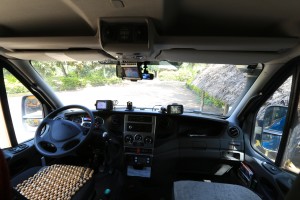
Go-anywhere, relatively easy to handle but still have the space for a reasonably sized living box on the back. Reasonable fuel economy (bearing in mind the weight being carried) and both of us can legally drive with our current UK driving licences. BUT we identified two main drawbacks: first, it would certainly not be as comfortably spacious as a big-rig. Secondly, it would carry far less weight. This challenges our Wish List requirements and reduces our water/fuel carrying capacity. Also, whichever vehicle we choose, Marcus-the-Techie will be doing most of the repairs and maintenance on the vehicle himself. Less capacity means carrying fewer tools and spare parts. It also means we can’t carry activity-things like bikes.
In the end, we felt that for us choosing an overland vehicle, the negatives of the mid-sized truck were more manageable than the negatives of the big-rig. The mid-sized truck won. It’s obviously not without its limitations but on-balance, it seems the best compromise option for us.
The Beauty of Hindsight: What would we change?
The Mid-sized Base Vehicle
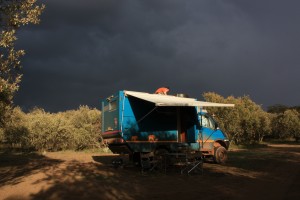
We looked at issues such as: off-road performance, size/width of the wheel-base, availability in the market, fuel economy, price, weight capacity, ease of maintenance, availability of spare parts/tyres around the world, and comfort in the driving cab. The new Iveco Daily 4×4 doesn’t necessarily get top marks in all these categories, but across most of them it scored better than its competitors (click here to see Marcus’ write-up on this decision). One major concern when choosing an overland vehicle for us, was the suitability of the Euro 5 engine to operate on poor quality fuel in Africa and South America.
With hind-sight? The Daily 4×4 isn’t perfect, but we wouldn’t change the decision. Click here to see the modifications and repairs that Marcus has done. It looks a long list, but many of these have been to suit our picky preference rather than essential work. Adding an electro-retarder to the braking system has been one of the most significant and in our view, necessary improvements. The benefits of the vehicle for us, particularly its phenomenal off-road, go-anywhere performance, far outweigh any work that has been required.
The concerns with poor quality fuel turned out to be largely ‘tish-tosh-and-piffle’. Even in the notoriously bad-fuel places such as Uganda and Bolivia. Operating at high altitude (say, over 4,000m) needs a little consideration (click here to see how we have managed the modern Euro 5 engine with poor fuel and high altitudes).
The weight balance of ‘water -v- fuel -v- general stuff’ is a constant battle so as not to overload and over-stress the axles, but this is a compromise we can live with (click here to see how we had the GVW re-plated from 5.5T to 5.9T in UK, and click here for our Trim Sheet page to see how we plan our fuel and water loads).
The Accommodation Box
Looking at particular specifications of the accommodation boxes offered by builders was confusing when choosing an overland vehicle. We decided to visit the Abenteur & Allrad Show in Bad Kissingen, Germany and we highly recommend this to anyone choosing an overland vehicle. Anyone who is anyone in the European overlanding and 4×4 community is there with a stand to show off their wares. It really opens your eyes to what is possible, whether to buy or to copy and build yourself. Here’s what we decided on:
The hard-shell ‘all-climate’ accommodation box
We got a full hard-shell box. We decided not to have any kind of ‘pop-up’. Sure, these are great for extra space but we reckoned that: a) it would compromise the insulation value; and b) over the long-term these are generally weak-points in a construction, they can disintegrate in certain conditions (e.g. high UV, in salty-air by beaches) and they risk water leaks.
With hind-sight? – We love it. Wouldn’t do anything different. It gives us the full flexibility of camping locations that we wanted. Excellent insulation saves us heating gas in cold climates. Unless it’s very cold outside, the heat from cooking inside is enough for us not to need the heating. A small draw-back of the insulation is that in hot climates, it can get too hot to cook inside. In rural areas we can cook outside on a fire; in hot-climate cities we eat salads or go to restaurants to avoid cooking.
One point that we were urged to consider when investing in the hard-shell box, is balancing of the cost against simply checking into an AirBnB or hostel for the nights when conditions look a bit uncomfortable. With hindsight, we can say that if you plan to stay in areas where reasonably priced alternative accommodation is available, then that is a fair option to consider. But if you want to experience the wilderness of some of the most spectacular travel locations in the world, you simply won’t have that choice. Parking up on remote lakeshores or mountainsides is unbeatable. Nothing compares to waking up in your own bed and watching sunrise in a remote spot of the high Andes (when it is -18C outside!).
What if, say, you want to ski the French Alps? There is plenty of accommodation around for rent, but at several hundred Euros per week during the main season, it won’t take long to add up to the cost of investing in your vehicle. In some parts of the developing world, there have been hostels that we could have checked into. But frankly, looking at them from the outside, I doubt that we would have emerged in the morning without some kind of new ‘friends’ in our scalp or under our skin 🙁
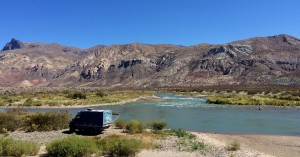
A home on wheels, not a car with a bed
Having a real home on wheels, we haven’t once been tempted to check-in to a hostel/lodge. The semi-permanent bed is a reasonable compromise for the bed-status-dilemma noted above. It takes 15 seconds to pull-out and all the bedding stays on the bed all the time (no bedding stowage required). With the bed pushed-in, we have reasonable move-around space for 2 people.
With hind-sight? We’d be telling porky-pie lies if we didn’t occasionally wish that we had more space. We are sometimes a teeny bit envious of travellers with big-rigs and more living space. We need to be super-organised living in a small space. However, on balance, we honestly wouldn’t change to a big-rig. Yes, the extra space would be nice, but not at the expense of all the other negatives that we identified regarding the big-rig trucks.
Water and bathroom
We have our ‘essential’ toilet. A separate bathroom with shower and a hot-water system wasn’t in our original Wish List, but they’re great and we’re happy that we have them. Click here for details of all the water systems.
We have a 230 litre fresh water tank and a 130 litre grey-water tank . We have constantly to review the fuel/water carried and the weight distribution of the various tanks around the vehicle. The axle limits mean that we can’t carry full fuel and full water at the same time. The water filtration system has two stages, finally down to 0.5 microns for drinking quality.
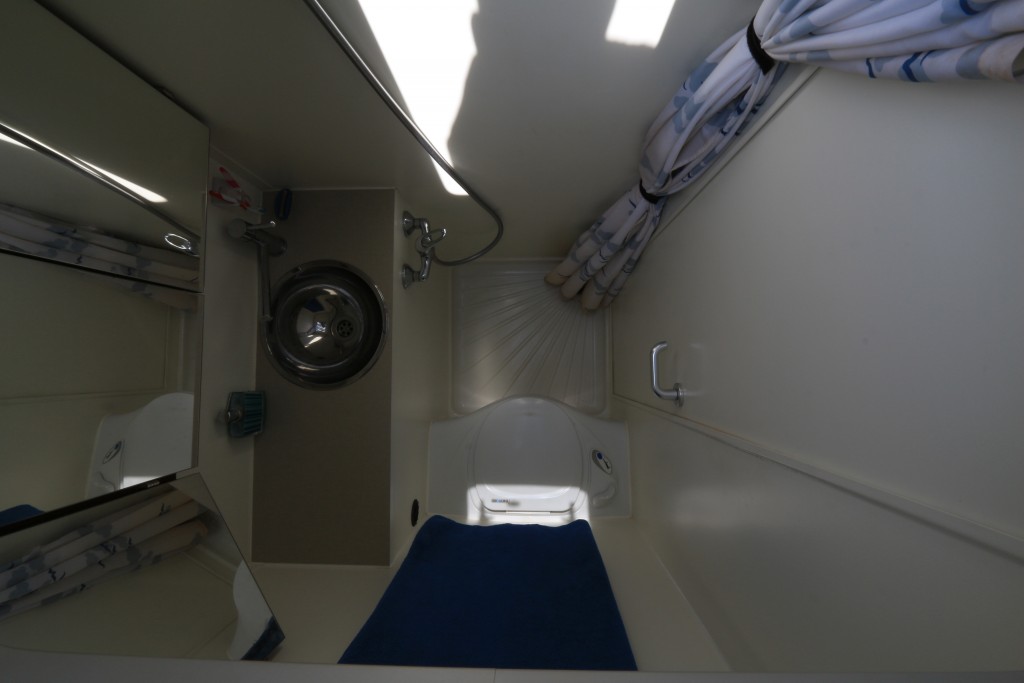
With hind-sight?
Toilet: Soooo glad we have this. It would be far outside our softie tolerance levels to go outside in the night, in cold, wet conditions to the loo. In the African bush, the first night you want the toilet and a lion is just out side roaring, makes you realise that you made the right decision! If we didn’t have the toilet in a separate bathroom, we would be perfectly happy with a well-designed cassette toilet (there are several on the market) in the main living area, provided it had a good stowage position in the fit-out.
Shower: For us, this is probably the least essential of our luxuries. Washing from a bowl and finding occasional showers in camp sites wouldn’t be the end of the world for us. However, these are often less than sanitary and I can understand why some people see having their own shower as important. Our plastic shower tray has scratched and discoloured quite badly. With hind-sight we would either research a tougher material tray, or put more effort into protecting the plastic tray in every-day use.
Fresh water: Initially we thought around 100 litres would be fine. We’re happy that we have 230 litres, but we could manage perfectly well with less. If we both shower every day, a full tank will last us around 5 days. Obviously, it lasts far longer if we ‘go-stinky’ and shower less regularly 😊.
Filtration: The filtration to 0.5 microns works well. We’ve up-loaded water from many natural sources and taps across Africa, South and Central America with no problems. All the fresh water flows through the full filter system. With hindsight, we would probably restrict this to one drinking tap only. It’s not necessary to have such high quality water for showering, washing-up etc. The excess use means the filters need changing more regularly and they are hard to find in some parts of the world. Having your drinking water filtered and out of a plumbed-in tap is far better than having to find potable water supplies all the time. It’s simply not available everywhere, particularly in some parts of Africa and remote parts of South America. It is also far more ecologically friendly than buying it in plastic bottles.
Power
Solar power allows us to be self-sufficient ‘off-grid’ in remote locations. This powers lighting, refrigeration, sockets for appliances and charging phones/ lap-tops. Click here to see details on the electric system. We decided we didn’t need a generator to supplement the solar (this is probably one of those luxuries that a big-rig can carry but we don’t have capacity for – click here for the generator decision). We have gas for cooking, heating and hot water (click here for the gas system details).
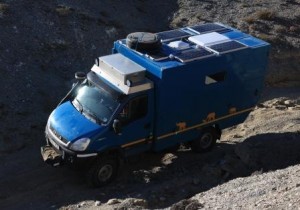
With hind-sight?
Solar: Stating the obvious…. solar power works well in sunny climates. It works fantastically well in high-altitude sunny climates. It doesn’t work so well in overcast climates and we have needed to be careful in temperate climates such as western Europe. The worst possible climates are overcast and hot (e.g. tropical regions in rainy season). Here the solar panels take little energy but the power-drain is high due to the fridge working hard to stay cool. To help deal with this, we added an extra solar panel on the roof, and changed to lithium batteries. A generator might have been nice on (literally) one or two occasions, but for us, it wouldn’t be worth schlepping one around the world. On very rare occasions it has been necessary, we have simply run the engine.
Gas (that’s ‘propane’ for North Americans): For cooking, heating and hot-water, gas is fine. There have been a couple of places in Africa and South America where refilling the tanks is not straight-forward but planning ahead and carrying a few filling adapters has dealt with any problems so far. There is a helpful Facebook page (Cooking gas around the world).
Temperature Control
Central heating was essential, but we decided against air-con.
With hind-sight?
Heating: Some of the most spectacular places we have been have been extremely cold: Salar de Uyuni in Bolivia was down to -18C at night but no overlanding trip to Bolivia is complete without a night out there! Canada during the covid lock-down winter was a chilly -32C !!!! The top-notch insulation and the small size of the space means that very little heating is required (particularly when we cook inside too).
Air-con: Air-con is the kind of extra luxury that a big-rig can probably carry, but for us it was the right decision not to have this. On a couple of occasions in the tropical heat and humidity it would have been nice to have this, but the battery drain would have been too much. A low-powered electric fan is usually adequate to create some air-movement to stay cool. We started with a ‘Fan-tastic’ but realised in the tropical rains that we ideally needed a model with a rain-hood (click here for our switch to a Maxx-Air model with a rain-hood).
Kitchen
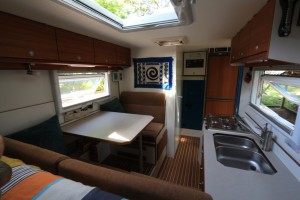
The plumbed-in kitchen sink has a cover plate that can be placed over the top for extra food prep space. For cooking we have two gas rings and a gas oven. We wanted a fridge and we have ended up having one with a small freezer compartment too. We decided against a microwave.
With hind-sight?
Cooking: The two gas rings are well used, but with hind-sight, the oven is not as essential as we thought it would be. The gas hob didn’t have a cover plate and seemed to be ‘dead space’ when not being used. We fitted an after-market lift-up top (click here for details) which now gives more useable space when not cooking. We wouldn’t use a microwave. I know that some overlanders in big-rigs love this, but leaving it out was a good decision for us.
Fridge/freezer: I love the front-door opening design, but the set-up really hasn’t been ideal for hot climates. Click here to see the problems we’ve had with the fridge and what we would do differently, although this has improved since we installed the lithium batteries.
Agree? Disagree? Want to shoot us down in flames???? 🙂 How did you go about choosing an overland vehicle? Let us know here
Back to Main Home Page. Back to Truck and Kit home page.
Back to Planning an Overland Trip home page
.
